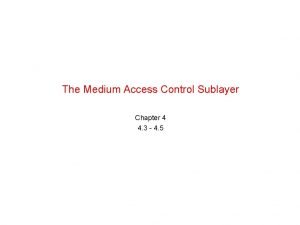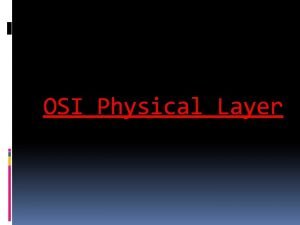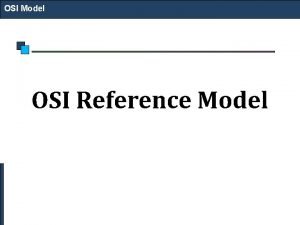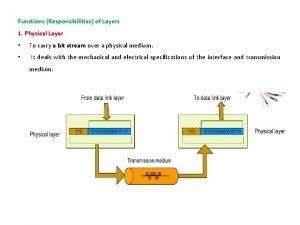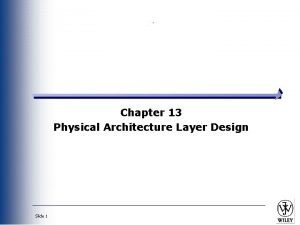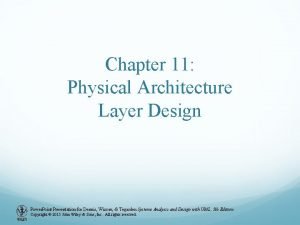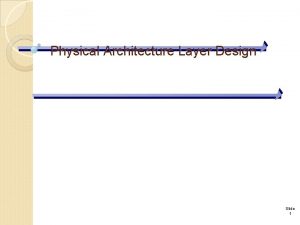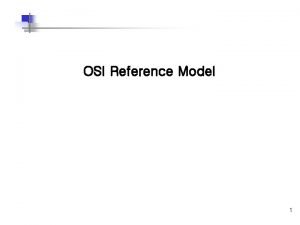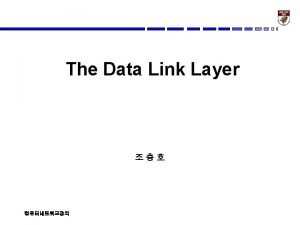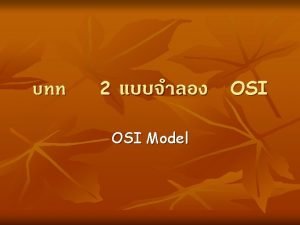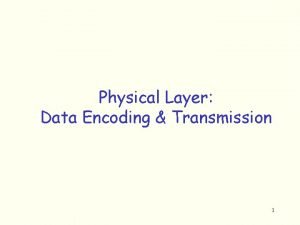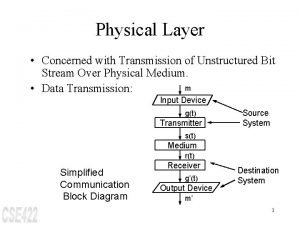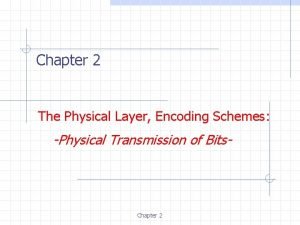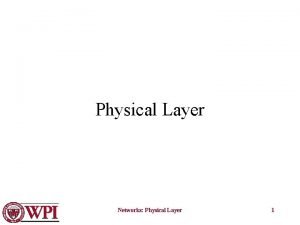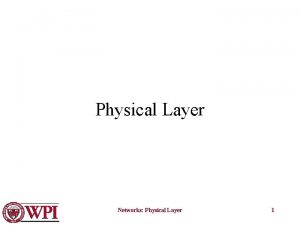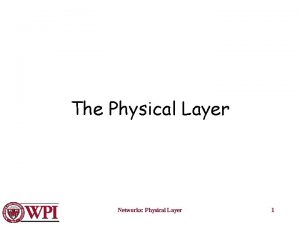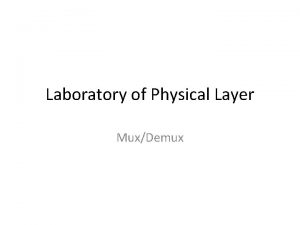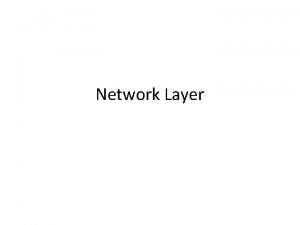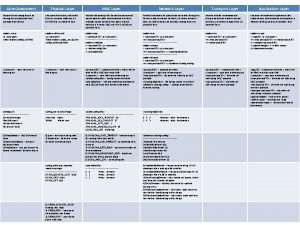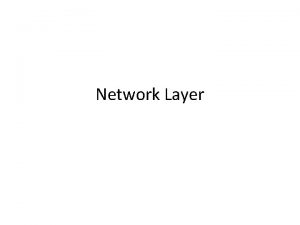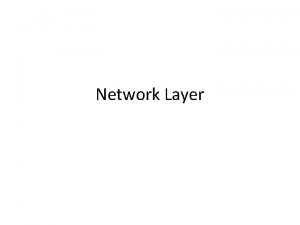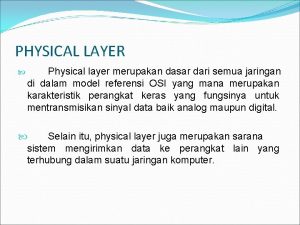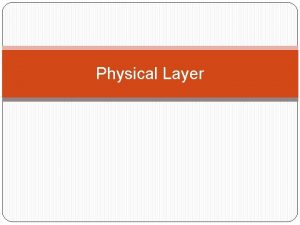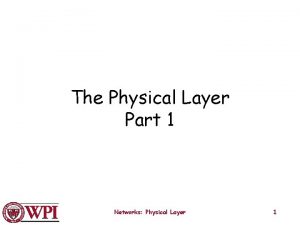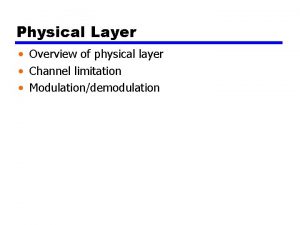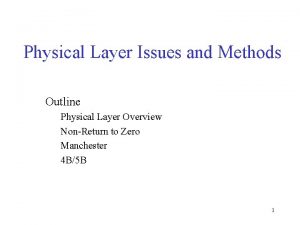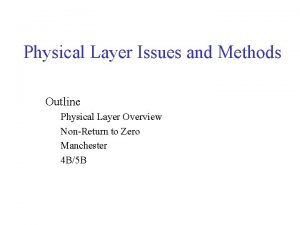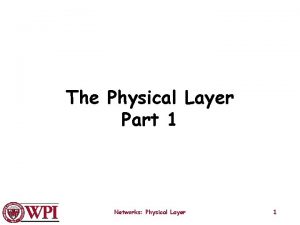Physical Layer contd l Telephone systems n referred


























- Slides: 26

Physical Layer (cont’d) l Telephone systems n referred to as PSTNs (Public Switched Telephone Systems) n high coverage n for voice and data n low speed and high bit error rate n an urge for higher efficiency to support data and multimedia applications 1

Physical Layer (cont’d) l Telephone systems (cont’d) n structure (Fig. 2 -14, p. 103) 2

Physical Layer (cont’d) l Telephone systems (cont’d) n structure (cont’d) (Fig. 2 -15, p. 105) 3

Physical Layer (cont’d) l Telephone systems (cont’d) n structure (cont’d) – transmission media l l twisted pair coaxial cable microwave fiber optics – advantages of digital trans. over analog trans. l l higher accuracy by data regeneration integrated services cheaper (only to correctly distinguish a 0 from a 1) easier maintenance (to track down problems) 4

Physical Layer (cont’d) l Telephone systems (cont’d) n structure (cont’d) – three major components of a telephone system l local loops (twisted pair, analog signaling, advanced technologies including DPGS, ADSL and HDSL) trunks (fiber optics or microwave, mostly digital) switching offices – CPE (customer premises equipment), e. g. telephones and fax machines, connected by a telephone system 5

Physical Layer (cont’d) l Telephone systems (cont’d) n politics of telephones (Fig. 2 -16, p. 107) n In Feb. 1996, restrictions were removed so that the cable TV, local phone, long distance and cellular companies can enter one another’s business. 6

Physical Layer (cont’d) l Telephone systems (cont’d) n local loop – typical configuration to support data communications ( Fig. 2 -17, p. 108) 7

Physical Layer (cont’d) l Telephone systems (cont’d) n local loop (cont’d) – transmission impairments l l l attenuation: distance and frequency dependent, recovered by amplifiers and equalizers delay distortion: caused by frequency-dependent propagation speeds, unavoidable noise: e. g. thermal noise, cross talk and impulse noise – modems l l l modulator and demodulator digital data, analog signaling and digital transmission using modulation to reduce the range of frequencies 8

Physical Layer (cont’d) l Telephone systems (cont’d) n local loop (cont’d) – digital modulation techniques (Fig. 2 -18, p. 110) 9

Physical Layer (cont’d) l Telephone systems (cont’d) n local loop (cont’d) – constellation patterns (Fig. 2 -19, p. 111) 10

Physical Layer (cont’d) l Telephone systems (cont’d) n local loop (cont’d) – digital modulation standards l l ITU V. 32: 9600 bps, 16 QAM ITU V. 32 bis: 14400 bps, 64 QAM ITU V. 34: 28800 bps ITU V. 90: 56000 bps – trellis coding, e. g. 128 points in the constellation pattern to send 6 data bits and 1 check bit in 1 baud – FDM (to disable noisy bands), compression and error correction to improve performance 11

Physical Layer (cont’d) l Telephone systems (cont’d) n local loop (cont’d) – echo suppresser for long distance transmission (Fig. 2 -20, p. 113) l l only half-duplex is possible with significant reverse time designed for human speech, not digital data in-band pure tone at 2100 Hz to disable the echo suppresser replaced by echo chancellors 12

Physical Layer (cont’d) l Telephone systems (cont’d) n RS-232 -C and RS-449 – standardized by EIA and ITU – physical layer specifications – to connect the computer and the modem – null modems to connect two devices without modems – 20 Kbps over 15 -meter trans. limit for RS-232 -C – 2 Mbps over 60 -meter trans. limit for RS-449 with RS 422 -A (balanced transmission) 13

Physical Layer (cont’d) l Telephone systems (cont’d) n fiber in the local loop – FTTH (Fiber To The Home) – FTTC (Fiber To The Curb) – HFC (Hybrid Fiber Coax) 14

Physical Layer (cont’d) l Telephone systems (cont’d) n trunks and multiplexing – FDM (frequency division multiplexing) (Fig. 2 -24, p. 119) 15

Physical Layer (cont’d) l Telephone systems (cont’d) n trunks and multiplexing – WDM (wavelength division multiplexing) (Fig. 2 -25, p. 120) l l l highly reliable (completely passive) desired due to the speed limit on E/O and O/E conversion can be used in the FTTC architecture 16

Physical Layer (cont’d) l Telephone systems (cont’d) n trunks and multiplexing (cont’d) – TDM (time division multiplexing) l l l digitizing voice by a codec (sampling and quantizing) PCM (Pulse Code Modulation) T 1 carrier (Fig. 2 -26, p. 122) 17

Physical Layer (cont’d) l Telephone systems (cont’d) n trunks and multiplexing (cont’d) – TDM (cont’d) l l DPCM (Differential PCM) DM (Delta Modulation) (Fig. 2 -27, p. 123) 18

Physical Layer (cont’d) l Telephone systems (cont’d) n trunks and multiplexing (cont’d) – TDM (cont’d) l carrier hierarchy (Fig. 2 -28, p. 124) 19

Physical Layer (cont’d) l Telephone systems (cont’d) n switching – from manual to automatic – schematic illustration (Fig. 2 -34, p. 131) 20

Physical Layer (cont’d) l Telephone systems (cont’d) n switching (cont’d) – comparison of switching techniques (Fig. 2 -35, p. 132) 21

Physical Layer (cont’d) l Telephone systems (cont’d) n switching (cont’d) – comparison of switching techniques (cont’d) (Fig. 2 -36, p. 134) 22

Physical Layer (cont’d) l Telephone systems (cont’d) n switching (cont’d) – switching hierarchy (Fig. 2 -37, p. 135) 23

Physical Layer (cont’d) l Telephone systems (cont’d) n switching (cont’d) – crossbar (crosspoint) switches (Fig. 2 -38, p. 136) – simplest and nonblocking – the number of crosspoints grows fast with n 2 24

Physical Layer (cont’d) l Telephone systems (cont’d) n switching (cont’d) – space division switches (Fig. 2 -39, p. 137) – smaller number of crosspoints – possible call blocking 25

Physical Layer (cont’d) l Telephone systems (cont’d) n switching (cont’d) – time division switches (Fig. 2 -40, p. 138) – the table size and the RAM buffer grow linearly with n 26
 Alliance future internetlapowskyprotocol
Alliance future internetlapowskyprotocol Embedded systems vs cyber physical systems
Embedded systems vs cyber physical systems Pigmented layer and neural layer
Pigmented layer and neural layer Brush border enzymes
Brush border enzymes Secure socket layer and transport layer security
Secure socket layer and transport layer security Layer 6 presentation layer
Layer 6 presentation layer Secure socket layer and transport layer security
Secure socket layer and transport layer security Secure socket layer and transport layer security
Secure socket layer and transport layer security Secure socket layer and transport layer security
Secure socket layer and transport layer security Layer 2 e layer 3
Layer 2 e layer 3 Layer-by-layer assembly
Layer-by-layer assembly Layer 2 vs layer 3 bitstream
Layer 2 vs layer 3 bitstream Classic ethernet physical layer
Classic ethernet physical layer What is the purpose of osi physical layer
What is the purpose of osi physical layer Osi reference model diagram
Osi reference model diagram Functionalities of physical layer
Functionalities of physical layer Physical architecture layer design
Physical architecture layer design Physical architecture layer design
Physical architecture layer design Physical layer transmission media
Physical layer transmission media Physical architecture layer design
Physical architecture layer design What is osi model explain?
What is osi model explain? Fungsi layer physical
Fungsi layer physical Physical layer coding violations
Physical layer coding violations Characteristics of llc sublayer
Characteristics of llc sublayer Physical layer encoding
Physical layer encoding The physical layer concerns with
The physical layer concerns with Physical layer encoding
Physical layer encoding












